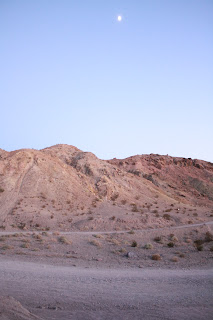Contrary to popular opinion, Barstow isn't too bad a place - it's not high on my list of vacation spots, but it is a decent enough place out of which to be based. It beats the hell out of Taft, at any rate.
We finish our work day a few hours before dark, and so I have been using my late afternoons/early evenings out exploring the area. Yesterday, I headed out to the Calico Hills, an area of interest to me for a few reasons.
There are claims that the Calico Hills was host to a Ghost Dance movement. The Ghost Dances were religious movements that had begun amongst the Paiute in Nevada and moved out among Native American groups during the 19th century (the best known being the one that sparked the massacre at Wounded Knee). They varied considerably from place to place, and were often known by names other than Ghost Dance. The ritual consisted of an extensive dance, coupled with lifestyle changes towards clean living, which would summon the ancestors (or, in some versions, the spirits worshiped by the ancestors) who would wipe the Europeans and their descendants from the Americas.
Needless to say, as often happens with apocalyptic religious movements, the members of the Ghost Dance cults were tragically wrong.
I have been unable to confirm whether or not there was a Ghost Dance cult involved in the Calico Hills. It may very well have, there were groups in the general vicinity who had been influenced by the Ghost Dance, but much of what is readily available about the Calico Hills cult comes from half-wit new age "spiritual investigators" and therefore isn't worth the air that the Wi-Fi on which I read about it penetrates.
The area was heavily mined for silver during the late 19th and early 20th centuries. The town (now ghost town and tourist attraction) of Calico Hills - about which more will be written in a following post - is partially in ruins and has been partially rebuilt. However, the tunnels for the silver mines are still present, if falling apart, and make for some interesting viewing.
Another interesting aspect of the Calico Hills is the alleged "early man site" - a site that allegedly has artifacts that date to up to 200,000 years old depending on what dates you accept. Now, I have not handled these alleged artifacts directly, but having seen photos, I am unconvinced. They do look like they might be artifacts...or they might be geofacts (naturally occurring rocks broken in ways that make them look like artifacts).Given the dearth of any other evidence of humans or pre-human hominids in the Americas prior to 20,000 years ago (the most reliably dated old deposits date to around 12,000 years ago, though that may be beginning to change), and the ambiguous nature of the Calico Hills items, it seems safe to say that they are likely just geofacts.
Regardless, the Calico hills have a weird, almost alien, beauty. And they made for an excellent place to relax and watch the sunset over the playa below and behind the mountains across the valley.








No comments:
Post a Comment